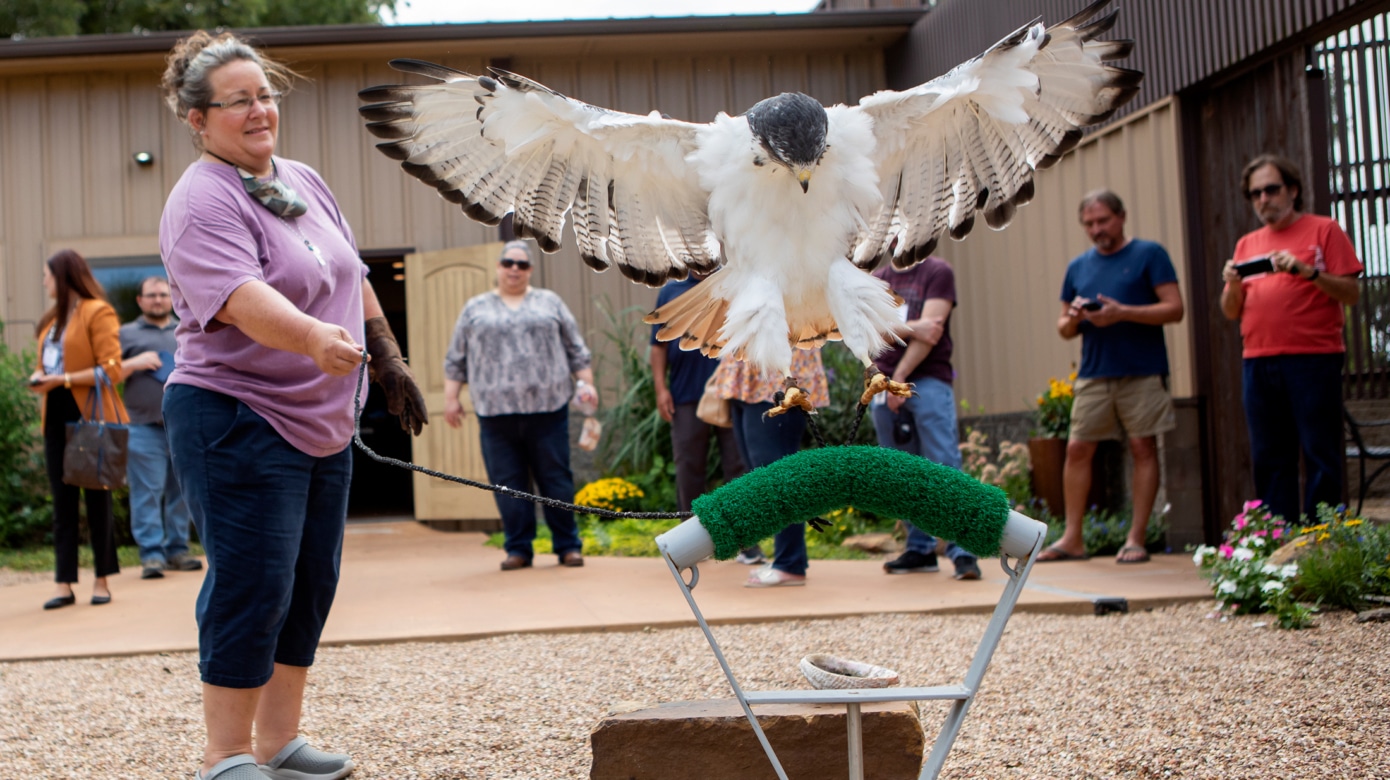October is National Field Trip Month. Citizen Potawatomi Nation offers area schools and youth groups two options for an exciting experience outside of the classroom.
The CPN Cultural Heritage Center and the CPN Eagle Aviary welcome group tours year-round. Some preparation before visiting will help teachers develop a lesson plan or other classroom activity, plus answer any questions they might have, said CHC Senior Curator Blake Norton. Aviary Manager Jennifer Randell said some groups visit both facilities on the same day, and both sites offer relevant information for most lesson plans, from history to science classes.
Cultural Heritage Center
Planning a visit to the CHC is easy. A virtual tour of the museum can be found at potawatomiheritage.com/360virtualtour.
“We have an extremely comprehensive, user friendly and enjoyable website (to help educators) prepare either a lesson plan or a more detailed field trip,” Norton said.
With a little preparation, a visit to the CHC can be tailored to suit the needs of the class.
“If you wanted to focus on a particular gallery, we can do that and just do some deep dives into that information for the class size or the age level. There are a lot of variables that can come into play that can make things a lot more positive and a lot more inclusive,” he said.
The visit can also be designed to suit the age level of the visitors, Norton said.
“Primarily for children or early elementary school children, we would mainly focus on our animated origin stories. It’s fun, it’s pretty captivating. It is comprehensive, but it’s easy to follow along,” he said.
The origin stories follow the millennia-long Potawatomi tradition of sharing history in an oral format.
“We really wanted to focus more on the audio components of it. If a young child was having a difficult time following along with the visuals and the animation, they could simply just sit back and listen to it. We wanted to honor the stories in that way, so we enhanced the reciting of the story itself. There’s an underlying score as well to create drama and help pace the story so you’re able to enjoy it in both fashions,” Norton said.
Young visitors will enjoy the Lifeways Gallery, focusing on activities that have seasonal significance.
“The focus is on the seasons, the moons and the activities through spring to summer, fall and winter. Each one of those are highlighted with specific activities and artifacts like our birch bark canoe, as well as the marine environment that we’ve created with specific fish that live in ecosystems in the Great Lakes, and botanicals to specific berries. (There is) a really cool wigwam that kids and adults are fascinated by. Over into fall, kids are interested in looking at our stone artifacts. And then we have an interactive display that takes us into winter and focuses on star knowledge and constellations,” Norton said.
Staff can even plan for teachers who are bringing combined grade-levels.
“It’s fun when you have a mixed age group of kids. It’s really rewarding watching the older kids tutor and mentor the younger kids when they’re asking questions, but also assisting them with our digital interactives and just watching the interaction between the kids,” he said. “We really wanted to create it that way as well for parents and children, too.”
To schedule, contact Senior Curator Blake Norton or Facilities Manager Keisha Wolf at 405-878-5830.
Eagle Aviary
CPN’s Eagle Aviary can help students learn about these majestic and culturally significant birds. Advance planning is required.
“I would say three months in advance for getting scheduled to come out here. You don’t always need that much time for smaller groups. But if they have 30 or 40 students, it’s better to plan in advance,” said Aviary Manager Jennifer Randell.
The Aviary wants to encourage all age groups to plan a visit. Randell looks forward to the perceptive questions the youngest visitors ask.
“I will tell you that the small kids, like our third or fourth graders, ask the best questions I’ve ever had to answer. It is really for all ages. And, if we have third graders, I might do a little different presentation than I do for high school students. But they all get a lot out of it,” she said.
Randell suggests visiting the Aviary’s website at potawatomiheritage.com/aviary to watch a few videos before a visit.
“It’s really helpful to have the students watch some of our videos online so they can see what they’re going to experience and maybe have questions ready. We love to answer questions. We do have an education bird out on the glove where they can get up close and personal,” Randell said.
“Then they actually will be able to go out and breathe the same air the eagles are breathing and get them as close as I hope they have ever been.”
The Aviary staff are happy to accommodate groups that would like to visit both the Aviary and the CHC.
“That’s a great option because they kind of intertwine, the cultural perspective we give them here, and then they actually can go see it at the museum. I really love that,” Randell said.
Other than this August’s periods of extreme heat, the Aviary is open year-round. Randell said the best time to see the Aviary’s eagles are in the cooler months when they’re more active.
“The eagles are more active in spring and fall. Winter for the eagles is their nesting season. So, they are a lot more vocal and active,” she said.
Generally, tours last from 45 minutes to an hour. The Aviary can comfortably accommodate about 35 students at a time.
Contact Eagle Aviary Manager Jennifer Randell at 405-863-5623, or aviary@potawatomi.org to schedule a visit.

